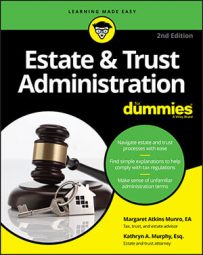After you create an initial inventory, you can begin tracking the activity in the trust account. Just like maintaining a running balance in your own checkbook, tracking this basic information helps in any number of ways. With it, you can determine how much is available to distribute to the income beneficiaries, while at the same time keeping track of the trust’s ongoing tax situation.
By recording all the transactions, you’ll gain some insight into how much you should charge for your trustee’s fee. So, every time you buy or sell a security, receive interest or dividend payments, or make any payments (taxes, fees, or beneficiary payments), you need to record that transaction. If there’s activity in the trust accounts, you need to capture it.
If you miss something along the way, watch out! When it comes time to create your annual account, missing transactions will mean that your account won’t balance.
Know the difference between income and principal
As you keep track of these transactions, you need to understand the difference between income and principal. Unlike your personal accounts, where you probably lump all your funds together and then pay your bills from the pot of cash, trusts differentiate between principal, or the assets of the trust, and income¸ or the money earned by the assets.
Distinguishing between income and principal can sometimes be confusing because certain types of income are actually considered principal (such as capital gains), and others remain segregated on the income side of the account.
However, just keeping track of the approximate records isn’t enough when administering a trust. Precision is the key to success, both for administration and for tax compliance, and no more so than when keeping track of basis information. (Basis is your carrying cost in any piece of property. It may be the price you paid for the property, the estate tax value if received from an estate, or any combination.)
You have to know what the trust’s cost is in an asset before you can make an informed decision as to what to do with it; should you decide to sell it, you need to know the basis, down to the last dollar, in order to correctly calculate the capital gain or loss.
Even though brokerages were required to begin reporting cost basis information to the IRS in 2011, that only relates to publicly traded securities acquired after December 31, 2010; for mutual funds, that date is December 31, 2011. Don’t rely on brokerages or mutual fund companies to keep track of your cost basis in securities you owned prior to those dates.
Typically, they’re satisfied with approximate costs for the non-covered securities (ones acquired before the magic dates of December 31, 2010 or 2011), so they do things like merge tax lots or fail to allocate basis to new companies spun off from a parent corporation. Why does it matter? Each time you buy a security, you create one tax lot; each time you sell, you may choose which lots you’re selling.
By designating which shares are sold, you can generate either a larger or smaller capital gain or loss, depending on what’s most advantageous to the trust. Keeping track of each specific tax lot allows you to keep all your options open.
Even if your broker supplies you with an informational schedule for your sales of non-covered securities with its version of gains and losses, you’re not obligated to use it — provided you have the supporting documentation necessary to back up yours.
For covered securities, though, you may want to pay closer attention over the course of the year to make sure that the records are correct. Now that the IRS is going to be matching up acquisition costs as well as sales proceeds, you’re far more likely to receive a notice from them if you report numbers different than your broker’s.
File estate income tax returns annually
A trust is a taxable entity, and any income it earns must be reported annually, either on the grantor’s Form 1040, in the case of a revocable trust, or on Form 1041, U.S. Income Tax Return for Estates and Trusts. Almost all trusts are required to file, using a calendar year (ending December 31), and the tax return is due on April 15 of the following year.
If you’re unable to complete and file the return by the filing deadline, you may file Form 7004, Application for Automatic 6-Month Extension of Time to File Certain Business Income Tax, Information, and Other Returns instead. Remember, any taxes owed for the prior year must be paid by April 15; the extension of time to file isn’t an extension of time to pay.

